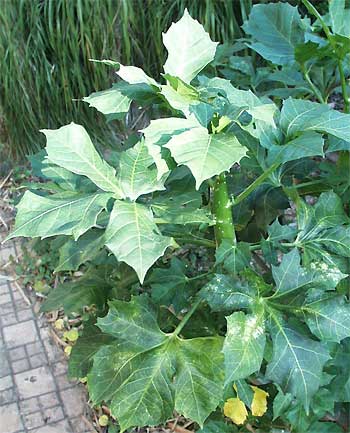Excerpts from Jim Conrad's
Naturalist Newsletter
from the February 4, 2006 Newsletter written at Hacienda San Juan Lizárraga
one kilometer east of Telchac Pueblo, Yucatán, MÉXICO
CHAYA
There's a local bush or small tree here, however, producing six-inch-wide, maple-like leaves that can be cooked like collard greens. They taste good and have surprisingly high levels of protein, calcium, phosphorus, iron and Vitamins C and A. The plant's local name is Chaya. It's CNIDOSCOLUS ACONITIFOLIUS ssp ACONITIFOLIUS, a member of the Euphorbia Family, which explains why its leaves look a little like Poinsettias, also of that family. That's it below:

Chaya is the domesticated form of a local weedy bush with soft leaves protected by abundant, nettle-like stinging spines. The wild species is called Mala Mujer, or "Bad Woman," maybe because it looks so good, but stings so smartly. In fact, even Chaya has some stinging hairs which leave the hands smarting after picking the leaves. Here average people eat Chaya regularly, typically mixing a few leaves into broths and stews containing ingredients such as squash, tomatoes, onions, chili, garlic and a few shreds of some poor old hen.
One of the wonderful things about Chaya is that you can simply poke a cut a stem into the ground and if you keep it watered it'll quickly grow into a new bush with plenty of leaves.